
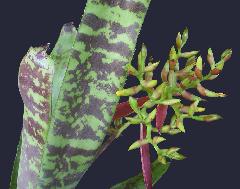


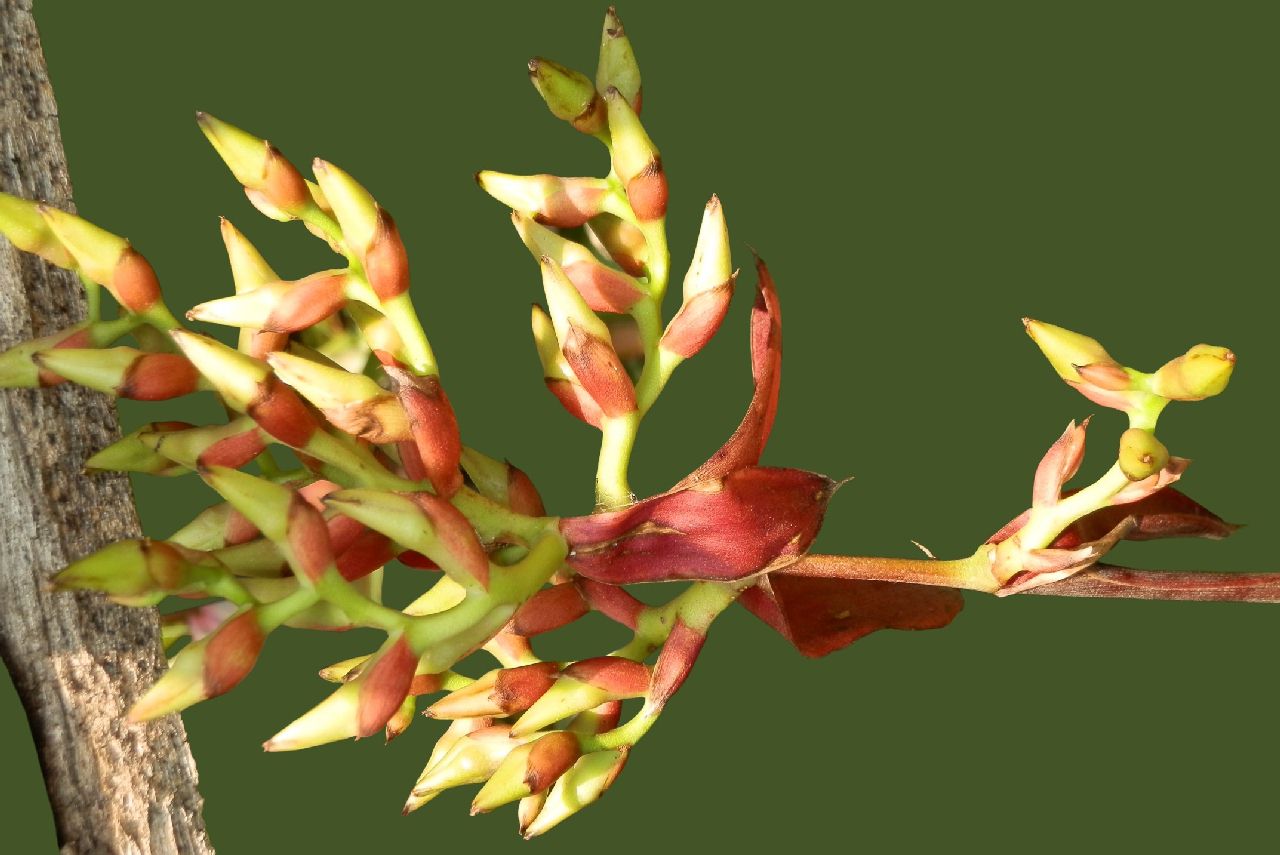

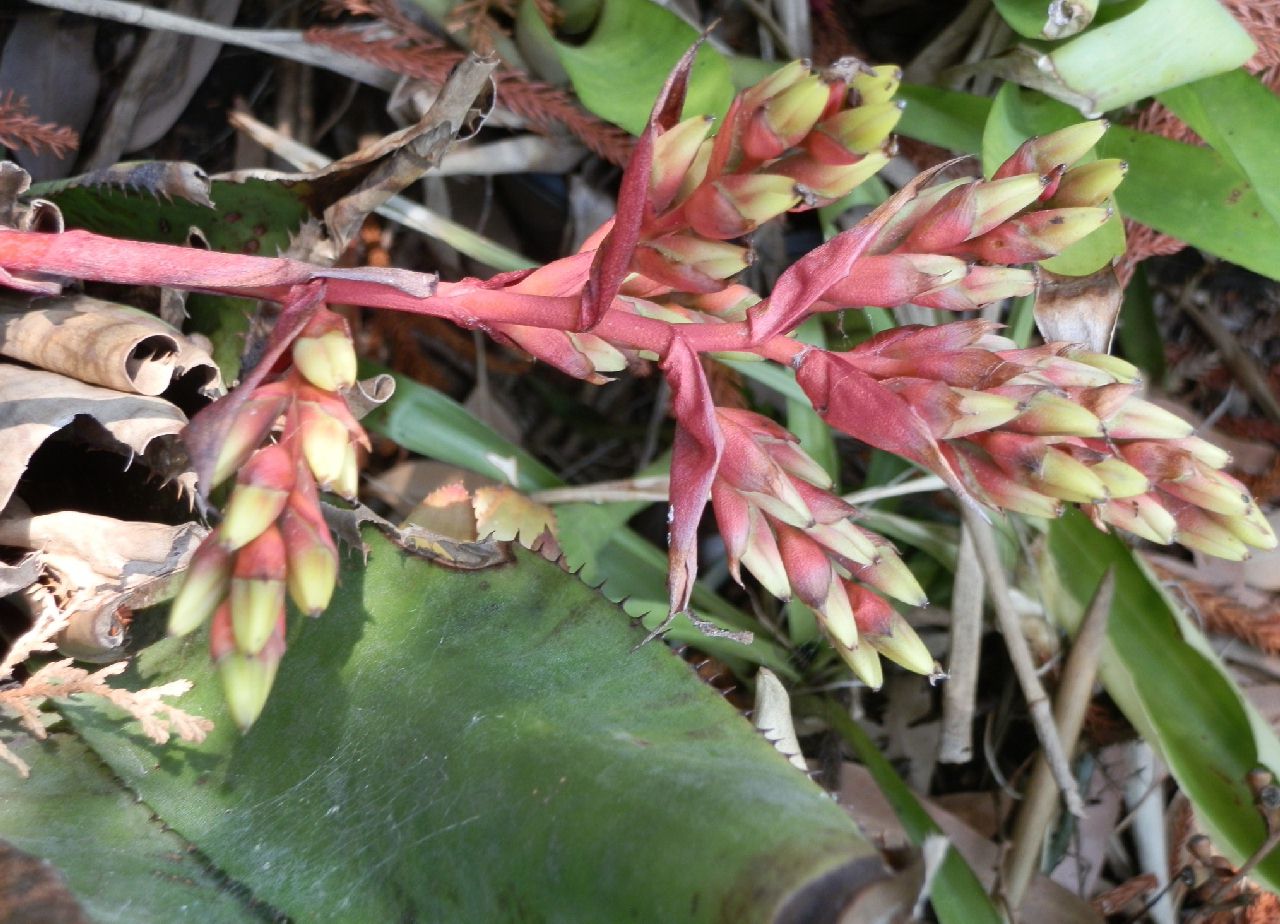
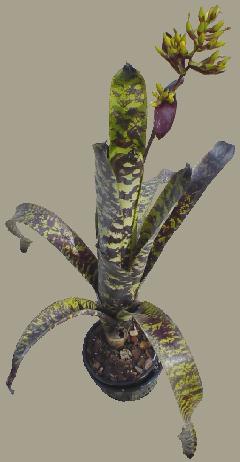
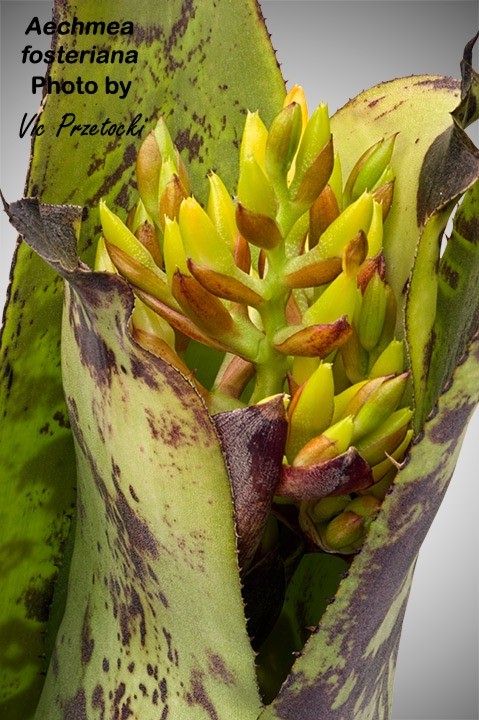



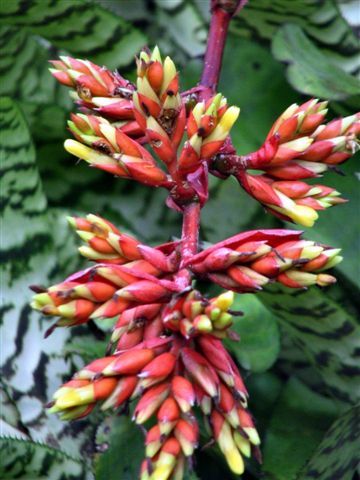
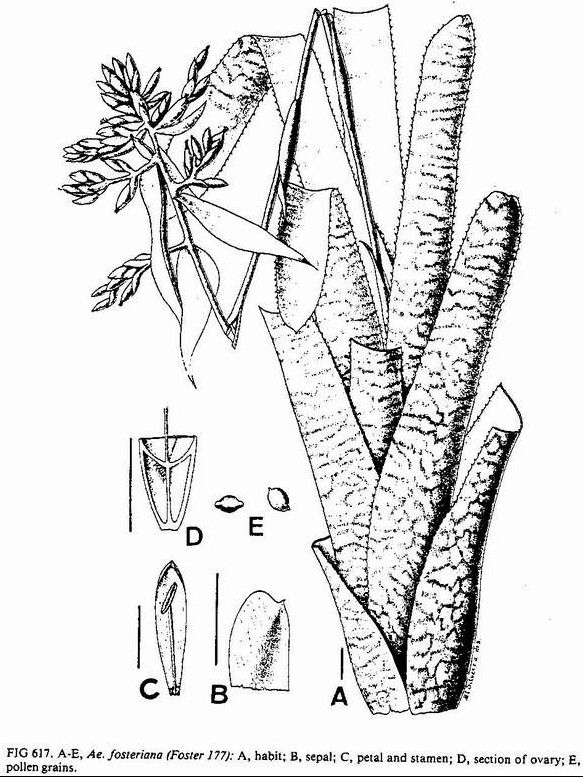
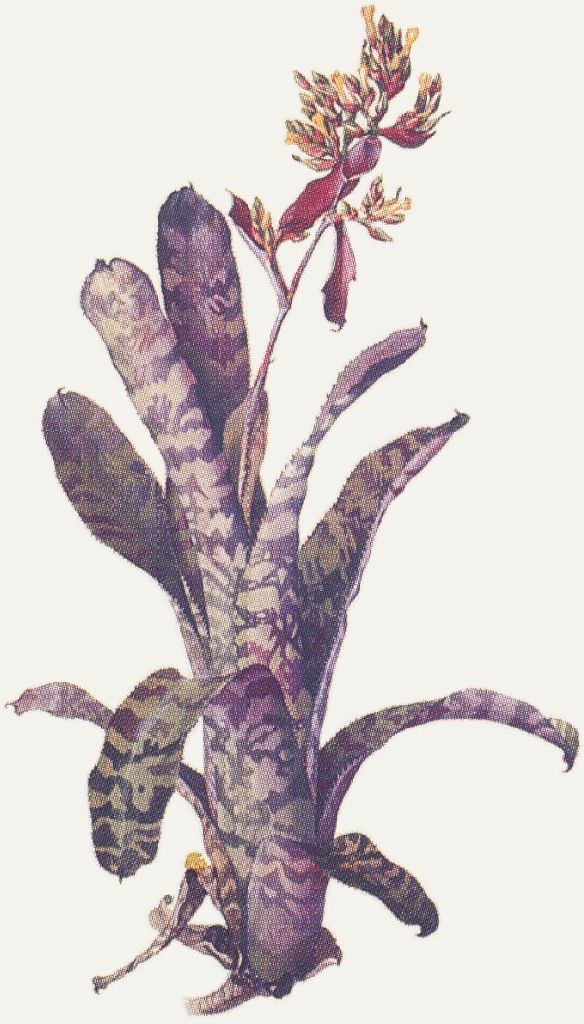


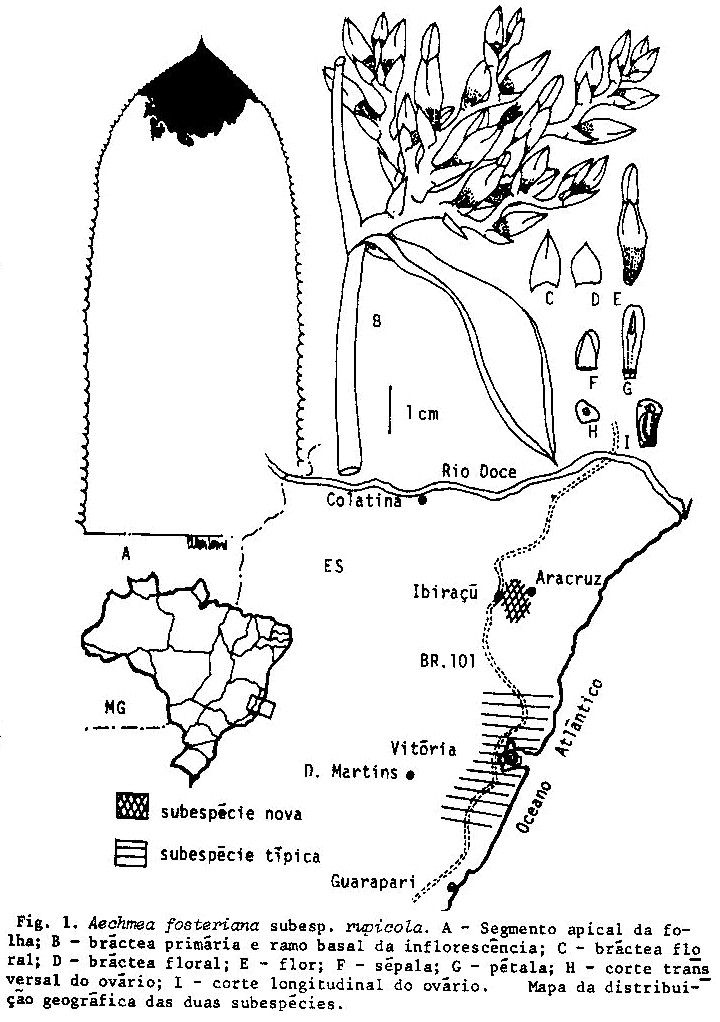
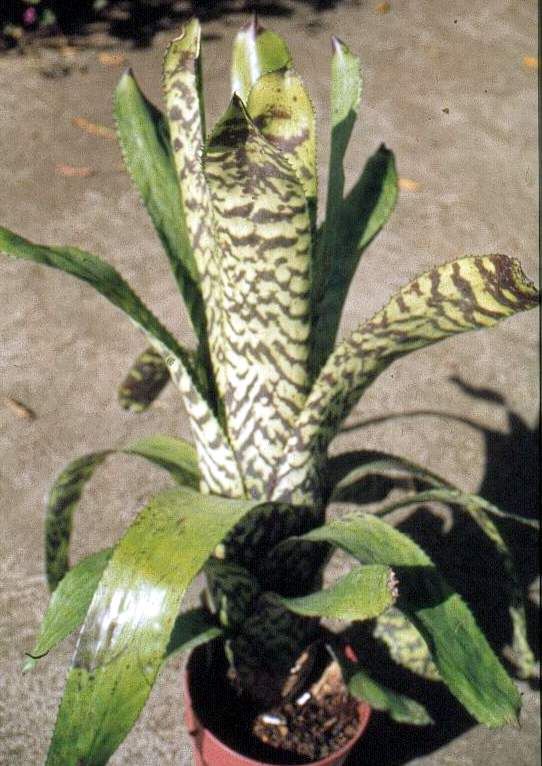

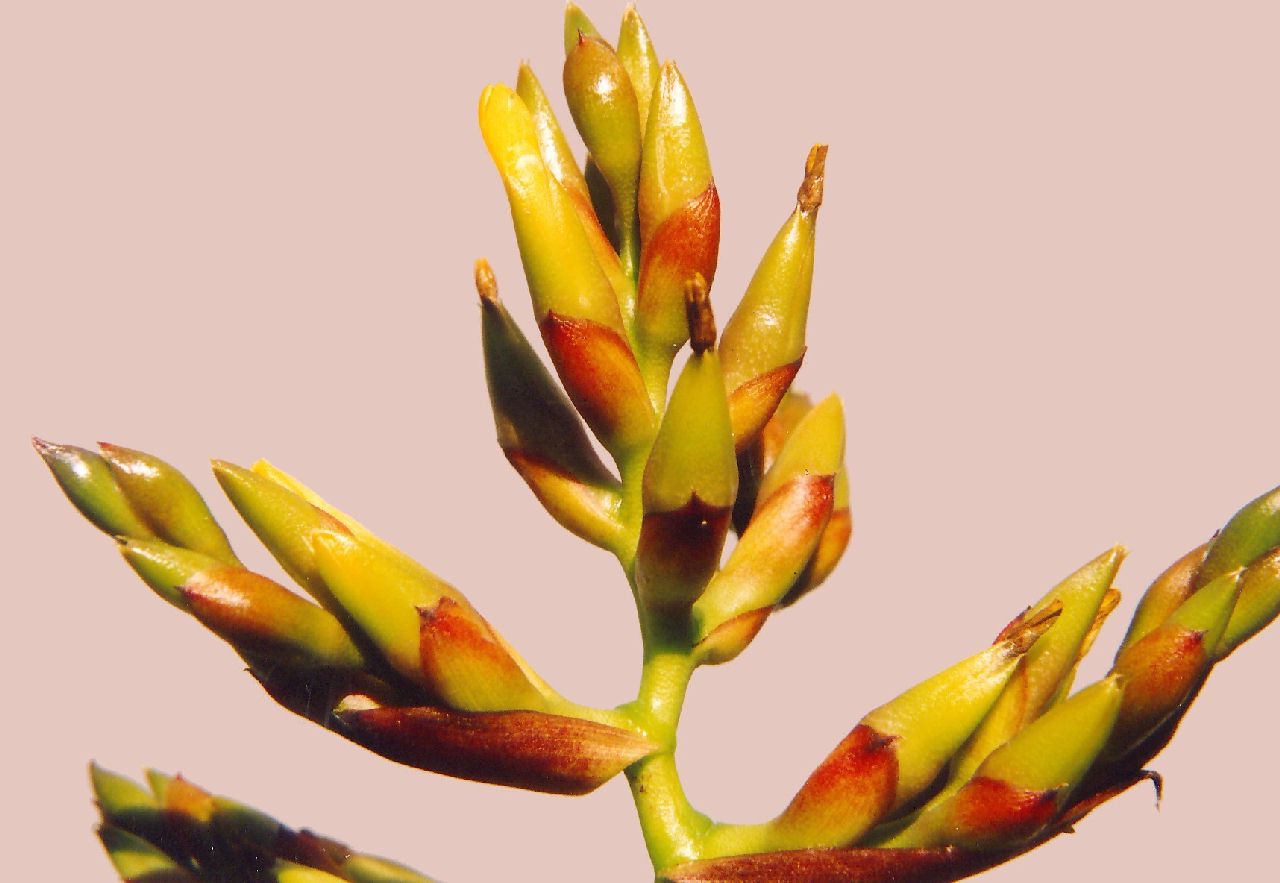
Aechmea fosteriana L. B. Smith, Arq. Bot. S. Paulo II. 1: 54, pI. 67. 1941.
Desc. from S&D
Plant flowering 6-9 dm high.
Leaves cylindric-rosulate, over 6 dm long, densely punctulate-lepidote on both sides; Sheaths elliptic, large, dark castaneous;
Blades erect or slightly divergent, ligulate, 6-10 cm wide, subdensely serrate with straight brown teeth 3 mm long, bearing brown-purple spots and a large dark purple one at the apex.
Scape erect, slender, glabrous, dark purple;
Scape-bracts much shorter than the internodes, elliptic, acute, membranaceous, punctulate-lepidote.
Inflorescence paniculate, laxly 3-pinnate;
Primary bracts like the scape-bracts, exceeding the branches, dark red within; spikes laxly 6-flowered, glabrous; rhachis geniculate.
Floral bracts suborbicular, apiculate, to 13 mm long, exceeding the ovary, broadly convex, ecarinate, red;
Flowers sessile, divergent, slightly more than distichous.
Sepals oblong, strongly asymmetric, broadly rounded and apiculate, 10 mm long, green;
Petals 16 mm long, orange, bearing 2 fimbriate scales at base, the blades broadly elliptic, subacute;
Stamens included; filaments of the second series highly adnate to the petals; pollen biporate;
Ovary turbinate, epigynous tube crateriform, 3 mm long; placentae apical; ovules apiculate.
Type. Foster 177 (holotype, GH), Vitoria, Espirito Santo, Brazil, 11 Ju11939.
Distribution. Terrestrial and epiphytic, along the coast, known from the type locality only: 9 Aug 1940, Foster 878 (GH, US).
Aechmea fosteriana ssp. rupicola Leme, Bradea 4; 392-3, 400. 1987
Plant growing on rocks, flowering ca. 85 cm high, stoloniferous, stolons ca. 15cm long, 15mm diam.,
Leaves ca 16, forming a rosette, ligulate, leathery, making an inflated tube at the base, outside leaves much shorter than the inside ones,
Sheath oblong-elliptical, 15-25cm long, ca. 10cm wide, both sides densely brown lepidote, inside almost black, outside light green,
Blade sub-linear, 20-40cm long, ca. 6cm wide, both sides sub-dense but inconspicuous white lepidote, becoming yellowish green, the tip sub-acute apiculate and with black spots, edges with dense spines, spines yellow ca. 1.5mm long,
Scape erect, 40-55cm long, ca. 5mm diam., greenish, mainly lepidote towards the base, scales fimbriate.
Scape bracts ca. 10cm long, ca 15mm wide, sub-linear, with acute tip finely apiculate, membranaceous, entire, green, both sides lepidote, clasping the scape, exceeds the internodes.
Inflorescence paniculate, tripinnate towards the base, lax or sub-dense, 20-25cm long, 7-11cm diam., exceeds the leaves,
Primary bracts similar to scape bracts but shorter, reflexed, becoming yellowish green, a little exceeding the lower branches or a little shorter.
Branches 8-10, sub-erect, short stemmed, sub-dense flowers, 5-7cm long,
Rhachis geniculate, greenish, 1-2.5mm diam.,
Floral bracts ovate, 8-12mm long, ca 6mm wide, membranaceous, lightly nerved, glabrous, entire, becoming yellowish green, ecarinate or keeled towards the tip, tip acute and minutely apiculate, equalling the ovary or a little shorter,
Flowers sub-erect, sessile or almost, 20-25mm long, polystichous and sub-dense.
Sepals asymmetric, oblong, ecarinate, free, 8-10mm long, ca5mm wide, glabrous, green, tip rounded apiculate.
Petals sub-spatulate, tip shallowly notched, 15mm long, ca 5mm wide, yellow, free, with 2 denticulate scales at base.
Stamens included; Filaments complanate, Series I free, Series II adnate hugh on petal; Anthers linear, 4mm long, blunt at base, tip apiculate, dorsifixed near the middle.
Ovary terete, clavate, 6-10mm long, 4-5mm diam., glabrous, pinkish; Epigynous tube inconspicuous; Placentae fixed in middle near tip; Ovules many, obtuse.
Type Espirito Santo, Municipality Aracuz, Estr. Aracruz-Ibiricu, On rocks, in the sun, 30m alt., Leg. E M C Leme 1126, R Menescal & R Bello, 16 May 1987, Holotype HB, Isotype RB.
Differs from type
Leaves yellowish green
Inside of sheath almost black
Inflorescence exceeds leaves
Primary and Floral bracts yellowish green
Ovary pinkish
Habitat on rocks
This new subspecies differs from the type A. fosteriana by the leaves of green-yellowish color, excepted for the inside face of the sheath and apex to the leaves that are almost black. It also differs from the subspecies fosteriana by the inflorescence that exceeds a little way the length of the leaves, primary and floral bracts yellow-greenish, a pinkish ovary and growing on rocks.
A typical A. fosteriana inhabits lowland areas of the Atlantic forest near the city of Vitoria (ES). It excelled as an epiphyte on the middle to upper parts of the trunks of primary forest trees, mesophytically, this subspecies fosteriana was practically eliminated from the area where formerly it was abundant. Destruction constitutes the main factor of its accelerated disappearance. However, small population pockets of this beautiful plant still can be observed - of easy cultivation and appreciated for the peculiar markings on their leaves - inhabiting remaining forest saved temporarily by the lessened activity of deforestation.
Regarding subspecies rupicola it is still little known concerning the current extension of its range. It seems to substitute the typical A. fosteriana in the area where inhabits, in the rnunicipio of Aracruz, approximately 60km north of the city of Vitoria (See map). It demonstrates perfect adaptation to the rocky area, with clear tendency towards sun-loving. These increased preferences were never observed for the subspecies fosteriana.
It is worth, finally, to observe that the recently described A. milsteiniana L.B. Smith & R.W. Read, starting from specimen of unknown origin which flowered in cultivation, presents a clear likeness to A. fosteriana, which was noted by the authors, and mainly with the new subspecies rupicola. However, it totally differs from both by the totally green leaves, with spines less than 5mm long, for the scape that much exceeds the length of the leaves, the whole of the inflorescence bipinnate, with primary and floral bracts of a yellowish green colour. And very possible that A. milsteiniana is better positioned taxonomically at infra-specific level to A. fosteriana; maybe as subspecies. However, to decide this, it would be necessary to unmask the mystery of the true natural origin of this species.